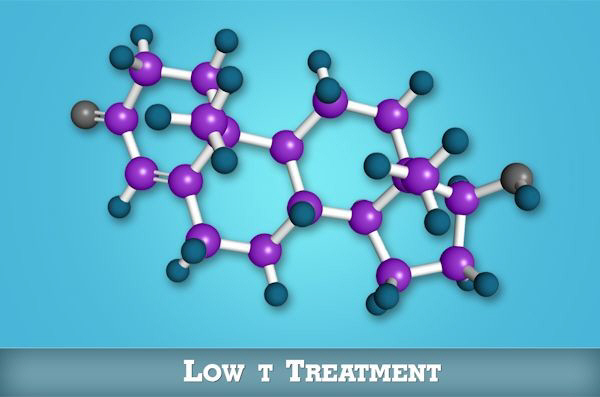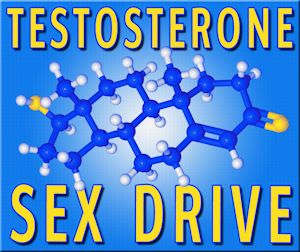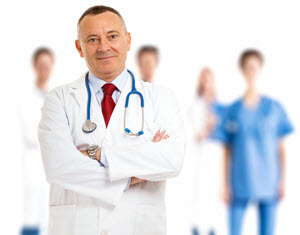Aging, Testosterone
Testosterone injections deliver testosterone into the muscle. The testosterone is then absorbed directly into the blood stream over time. The absorption period depends on the type of testosterone injected. Injections usually take place in the thighs, glutes or deltoid muscles.
Read on to learn about the most common forms of injectable testosterone, therapeutic dosages, pros and cons of testosterone injections, and injection demonstration resources.
The most common forms of injectable testosterone for testosterone replacement therapy (TRT) include testosterone enanthate (TE) and testosterone cypionate (TC). Testosterone enanthate and testosterone cypionate are modified forms of testosterone. Specifically, a carboxylic acid ester has been added to the 17-beta hydroxyl group. This attachment makes TE and TC less polar than free T. As a result, they have longer half-lives and are absorbed more slowly from the injection area. Once in the bloodstream, the ester is removed to yield free (active) T. Due to their long half-lives, both TE and TC provide a sustained release of testosterone into the bloodstream for one to two weeks. As a result, testosterone injections of TE or TC need only be administered every week or every other week.
Half-Lives of TE and TC
Testosterone enanthate possesses a half-life of roughly 8-10 days.7 Testosterone cypionate possesses a half-life of roughly 10-12 days.7 [Half-lives depend on a persons own rate of metabolism, so they may vary.] Therefore, it takes approximately 8 to 10 days for the body to metabolize and clear half the concentration of the testosterone enanthate following an injection. As a result, users need only inject every week or every other week. Find resources on how to give testosterone shots below.
Dosing Regimens for TRT
The recommended dosing regimen of testosterone enanthate or testosterone cypionate for testosterone therapy is 75 to 100 mg every week or 150 to 200 mg every other week.1-5 Weekly injections are preferred because more frequent injections lower fluctuations in serum testosterone. About 30% of men treated for low testosterone use testosterone injections. [About 65% of men use testosterone gel.]6
Following an injection of testosterone enanthate or testosterone cypionate, T levels exceed normal physiological levels for the first two to three days. Levels then steadily decline to levels below normal just prior to the next injection. The graphic below illustrates the fluctuation in T levels. Shortening the interval between testosterone injections and lowering the dose can minimize this cyclical nature of highs and lows, which is why weekly injections of 75 to 100 mg are preferred to every other week injections of 150 to 200 mg.
Of note, another testosterone ester, testosterone undecanoate, has been approved that maintains T levels in normal ranges.7-9
In addition to not mimicking physiologic dosing, injectable testosterone also show a stronger impact on raising red blood cell levels than transdermal options.10-13 Testosterone stimulates the production of red blood cells. In most cases the increase in red blood cells is small (2-5%) and within a safe range. However, for a considerable number of TRT users, testosterone injections produce red blood cell levels above safe levels over 50%. This increase in red blood cells causes your blood to become more viscous. Blood that is too viscous increases your risk of forming blood clots, which can subsequently lead to a heart attack and/or stroke.
Men using injectable testosterone should be vigilant in monitoring for this particular problem. A simple measure of your red blood cell count can alert your physician of this problem, which can then be treated. Lowering the injectable dosage and shortening the time between injections may potentially reduce the possibility of this side effect.
Recently, the US FDA approved injectable testosterone undecanoate (2014). Endo Pharmaceuticals will market it under the brand name Aveed. Testosterone undecanoate has actually been available under the brand name Nebido for over 10 years outside the US. Testosterone undecanoate is very slow acting. The drug provides a sustained release of testosterone into the bloodstream for up to 10 weeks.
In its Phase 3 Study, treatment with AVEED 750 mg maintained T levels in the normal range over 10 week dosing interval.6,14 The figure below illustrates T levels after the third injection. While testosterone undecanoate does not raise levels above normal, testosterone injections of TU still do not mimic physiologic dosing.
Both testosterone enanthate and testosterone cypionate are widely available in generic forms from compounding pharmacies. Also, most of the major low testosterone clinics use testosterone injections as the preferred testosterone replacement therapy administration method (See EMGs Testosterone Resource Center for more information on the major low testosterone clinics). Testosterone undecanoate is marketed under the brand name Aveed by Endo Pharmaceuticals.
For injection information, the University of Michigan provides a detailed PDF primer on How to give a Testosterone Intramuscular (IM) Injection. A video demonstration can be found at LowTestosterone.coms Intramuscular Injection Video. Also, ask your physician to explain and demonstrate the technique.
Below is a discussion of common testosterone esters. The primary difference between esters is the rate at which testosterone enters the bloodstream following an injection. A slower release means fewer testosterone injections per year. Testosterone propionate is a fast-acting ester rarely used in TRT. Testosterone enanthate and testosterone cypionate are slow-acting injectable forms. They have been the predominant form used for TRT. Testosterone undecanoate is a newly approved form that is very slow-acting.
Testosterone cypionate is a slow-acting injectable form of the androgen testosterone. Following deep intramuscular injection, the drug provides a sustained release of testosterone into the bloodstream for 2 to 3 weeks.14 Testosterone cypionate possesses a half-life of 10-12 days. The most commonly recommended dosing regimen for TRT is is 75 to 100 mg every week or 150 to 200 mg every other week. Typically, 26-52 injections are required per year.
Similar to testosterone cypionate, testosterone enanthate is a slow-acting injectable form of the androgen testosterone. Following deep intramuscular injection, the drug provides a sustained release of testosterone into the bloodstream for 2 to 3 weeks.14 Testosterone enanthate possesses a half-life of 8-10 days. The most commonly recommended dosing regimen for TRT is is 75 to 100 mg every week or 150 to 200 mg every other week. Typically, 26-52 injections are required per year.
In comparison to testosterone enanthate and testosterone cypionate, testosterone propionate is a faster-acting form of the androgen testosterone. Testosterone propionate possesses a half-life of roughly 1-2 days. Therefore, testosterone propionate does not provide a sustained release. Due to this short half-life, it must be injected every other day or every third day. As a result, it is rarely used for TRT.
Testosterone undecanoate is very slow-acting injectable form of the androgen testosterone. Following deep intramuscular injection, the drug provides a sustained release of testosterone into the bloodstream for up to 10 weeks. Testosterone undecanoate has been available under the brand name Nebido for over 10 years in more than 80 countries. However, it was not approved for use in the US.
Recently, however, the US FDA approved injectable testosterone undecanoate (2014). Endo Pharmaceuticals will market it under the brand name Aveed. Aveed is a depot formulation of testosterone undecanoate (TU) indicated for long-term TRT. Testosterone injections of 750 mg Aveed maintain normal levels between 300 and 1000 ng/dL for up to 10 weeks. Following baseline administration of 750 mg, a second 750 mg dose is given at 4 weeks followed by 750 mg every 10 weeks thereafter.
Due to the very slow-acting nature, Aveed will offer men with low testosterone a more convenient treatment option than currently available preparations. The injection interval for TU, after the loading dose, is 10 weeks. This equates to approximately 5 injections per year. In comparison, testosterone gels require daily dosing and testosterone enanthate and testosterone cypionate require injections every other week (26 injections per year).
EMGs TRT Resource: Types of Testosterone
External Resources: Medscape: Types of Testosterone
Updated: June 17, 2015
1. Corona G, Rastrelli G, Forti G, Maggi M. Update in TRT for men. J Sex Med. Mar 2011; 8 (3): 639-654; quiz 655.
2. Miner MM. Low Testosterone Medscape CME Expert Column Series. Issue 3: Delivering Safe and Effective TRT. Medscape Education. 2011.
3. Edelstein D., Dobs A., Basaria A. Emerging drugs for hypogonadism. Expert Opin. Emerg. Drugs. 2006; 11(4): 685-707.
4. Bhasin S, Cunningham GR, Hayes FJ, et al. TRT in adult men with androgen deficiency syndromes: An Endocrine Society clinical practice guideline. J Clin Endocrinol Metab. 2010; 95(6): 25362559.
5. Kaufman JM, Vermeulen A. The decline of androgen levels in elderly men and its clinical and therapeutic implications. Endocr. Rev. 2005; 26: 833-876.
7. Dobs AS, Meinkle AW, Arver S, Sanders SW, Caramelli KE, Mazer NA. Pharmacokinetics, efficacy, and safety of a permeation-enhanced testosterone transdermal system in comparison with bi-weekly injections of testosterone enanthate and testosterone cypionate for the treatment of hypogonadal men. J Clin Endocrinol Metab. 1999; 84: 3469-3478.
8. Mackey MA, Conway AJ, Handelsman DJ. Tolerability of intramuscular injections of testosterone ester in oil vehicle. Hum Reprod. 1995; 10(4): 862-865.
9. Saad F, Aversa A, Isidori AM, Zafalon L, Zitzmann M, Gooren L. Onset of effects of testosterone treatment and time span until maximum effects are achieved. Eur J Endocrinol. 2011; 165(5): 675-685.
10. Claustres M, Sultan C. Androgen and erythropoiesis: evidence for an androgen receptor in erythroblasts from human bone marrow cultures. Horm Res. 1988; 29 (1): 17-22.
11. Drinka PJ, Jochen AL, Cuisinier M, Bloom R, Rudman I, Rudman D. Polycythemia as a complication of TRT in nursing home men with low testosterone levels. J Am Geriatr Soc. Aug 1995; 43 (8): 899-901.
12. Jockenhvel F, Vogel E, Reinhardt W, Reinwein D. Effects of various modes of androgen substitution therapy on erythropoiesis. Eur J Med Res. Jul 1997; 2 (7): 293-298.
13. Gu Y, Liang X, Wu W, et al. Multicenter contraceptive efficacy trial of injectable testosterone undecanoate in Chinese men. J Clin Endocrinol Metab. 2009; 94(6): 1910-1915.
14. Schulte-Beerbhl M, Nieschlag E. Comparison of T, DHT, LH, and FSH in serum after injection of testosterone enanthate of testosterone cypionate. 1980 Feb;33(2):201-3.
Continue reading here:
Testosterone Injections - Elite Men's Guide
Contact Us Today For A Free Consultation

- Wall Street’s Castration Not Just Metaphorical [Last Updated On: October 24th, 2015] [Originally Added On: February 14th, 2012]
- Testosterone Roundtable -- Low Testosterone Treatment Options (Part 5) - Video [Last Updated On: December 30th, 2024] [Originally Added On: November 2nd, 2012]
- Military press 90lb dumbbells 40 years old - Video [Last Updated On: December 30th, 2024] [Originally Added On: November 2nd, 2012]
- Testosterone Injections: How To Inject Testosterone - Low Testosterone Treatment - Video [Last Updated On: December 31st, 2024] [Originally Added On: November 2nd, 2012]
- Free truth about 6 pack abs - Video [Last Updated On: February 16th, 2025] [Originally Added On: December 10th, 2012]
- Free free lower ab workouts muscles - Video [Last Updated On: February 17th, 2025] [Originally Added On: December 10th, 2012]
- Free abs circle pro workout - Video [Last Updated On: February 17th, 2025] [Originally Added On: December 10th, 2012]
- the truth about 6 pack abs ebook - Video [Last Updated On: February 18th, 2025] [Originally Added On: December 10th, 2012]
- the truth about 6 pack abs amazon - Video [Last Updated On: February 18th, 2025] [Originally Added On: December 10th, 2012]
- What Are Testosterone Injections? - Video [Last Updated On: January 18th, 2013] [Originally Added On: January 18th, 2013]
- Testosterone Injections Side Effects - Buzzle [Last Updated On: December 2nd, 2017] [Originally Added On: October 31st, 2013]
- Testosterone Injections - Steroid .com - Anabolic Steroids ... [Last Updated On: January 26th, 2018] [Originally Added On: October 31st, 2013]
- Testosterone Injections for Men | eHow - eHow | How to Videos ... [Last Updated On: December 31st, 2017] [Originally Added On: October 31st, 2013]
- Testosterone Injections - Testosterone Injections for Men and Women [Last Updated On: June 18th, 2016] [Originally Added On: October 31st, 2013]
- Testosterone Injections for Low Testostosterone Treatment @ www ... [Last Updated On: September 10th, 2025] [Originally Added On: November 2nd, 2013]
- How Intramuscular Testosterone Injections is Done? - Video [Last Updated On: November 14th, 2013] [Originally Added On: November 14th, 2013]
- Testosterone Replacement Therapy: Testosterone Injections ... [Last Updated On: December 3rd, 2017] [Originally Added On: November 19th, 2013]
- Testosterone Injections for Low Testostosterone Treatment ... [Last Updated On: September 9th, 2025] [Originally Added On: November 19th, 2013]
- Testosterone Injections - Steroid .com [Last Updated On: January 16th, 2018] [Originally Added On: December 19th, 2013]
- Side Effects of Testosterone Injections | eHow [Last Updated On: December 22nd, 2017] [Originally Added On: December 24th, 2013]
- When You Inject Testosterone Be Aware Of The Possible Mood Swing Side Effects [Last Updated On: March 28th, 2020] [Originally Added On: January 9th, 2014]
- Testosterone Injections for Men - Shots, Side Effects ... [Last Updated On: March 27th, 2020] [Originally Added On: January 19th, 2014]
- Medical board charges Modesto doctor with negligence in weight-loss program [Last Updated On: September 15th, 2025] [Originally Added On: January 23rd, 2014]
- Boy who lost testicles during OHSU surgery awarded no money by Portland jury [Last Updated On: April 13th, 2025] [Originally Added On: January 24th, 2014]
- Kindergartner gets no money for lost testicles [Last Updated On: January 7th, 2018] [Originally Added On: January 24th, 2014]
- Testosterone Injections for Men | eHow - eHow | How to ... [Last Updated On: January 17th, 2018] [Originally Added On: January 24th, 2014]
- Testosterone Injections for Women - Buzzle [Last Updated On: October 10th, 2020] [Originally Added On: January 30th, 2014]
- Testosterone Injections for Men | eHow eHow | How to [Last Updated On: October 8th, 2020] [Originally Added On: April 14th, 2014]
- Growing pains on testosterone with fibromyalgia. - Video [Last Updated On: November 26th, 2020] [Originally Added On: April 17th, 2014]
- Testosterone Injections: Uses, Side Effects & Warnings ... [Last Updated On: January 12th, 2018] [Originally Added On: April 18th, 2014]
- Testosterone Injections | Get Low Testosterone Therapy at ... [Last Updated On: November 28th, 2020] [Originally Added On: April 30th, 2014]
- Shot Day For Me! - Video [Last Updated On: October 30th, 2020] [Originally Added On: July 13th, 2014]
- MegaTEST 500 - Video [Last Updated On: November 15th, 2020] [Originally Added On: September 13th, 2014]
- Testosterone Injections Side Effects & Benefits [Last Updated On: October 27th, 2020] [Originally Added On: October 28th, 2014]
- All about Testosterone Injections - 2014's Best 3 ... [Last Updated On: November 19th, 2020] [Originally Added On: December 2nd, 2014]
- TESTOSTERONE | Testosterone Injections | Testosterone ... [Last Updated On: November 25th, 2020] [Originally Added On: February 23rd, 2015]
- Male Testosterone Therapy - Renew Man [Last Updated On: October 16th, 2020] [Originally Added On: February 23rd, 2015]
- Testosterone Injection - SteroidAbuse .com [Last Updated On: October 12th, 2020] [Originally Added On: March 23rd, 2015]
- Happy Mondays Star Shaun Ryder Needs Testosterone Injections To Stay Alive [Last Updated On: November 12th, 2020] [Originally Added On: April 9th, 2015]
- LowTestosterone.com - Proper Injection and Dosing ... [Last Updated On: October 15th, 2020] [Originally Added On: May 13th, 2015]
- testosterone injections withdrawal - Men's Health - MedHelp [Last Updated On: March 20th, 2016] [Originally Added On: May 28th, 2015]
- Risk of Testosterone Injections | eHow [Last Updated On: November 10th, 2020] [Originally Added On: October 14th, 2015]
- Treatment for Hypogonadism with Testosterone Injections [Last Updated On: March 20th, 2016] [Originally Added On: October 21st, 2015]
- Testosterone Injections - Testosterone Injections for Men [Last Updated On: November 18th, 2020] [Originally Added On: April 30th, 2016]
- Testosterone Injections For Women: Benefits & Side Effects [Last Updated On: October 15th, 2020] [Originally Added On: May 4th, 2016]
- Testosterone Replacement Beneficial for Modern Men? [Last Updated On: March 16th, 2025] [Originally Added On: February 11th, 2020]
- Learning About Testosterone: Testosterone Esters [Last Updated On: July 3rd, 2024] [Originally Added On: August 13th, 2020]
- Treatment for male menopause [Last Updated On: November 15th, 2024] [Originally Added On: October 19th, 2020]
- Testosterone Injection Replacement Therapy for Low-T [Last Updated On: September 17th, 2023] [Originally Added On: November 17th, 2020]
- Testosterone Therapy Can Help Men With Risk of Heart Failure [Last Updated On: February 22nd, 2024] [Originally Added On: February 5th, 2021]
- Testosterone Injections for Men - Men's Hormonal Health [Last Updated On: May 21st, 2021] [Originally Added On: May 21st, 2021]
- How Testosterone Benefits Your Life [Last Updated On: October 18th, 2024] [Originally Added On: January 17th, 2022]
- Testosterone: The Key to Male Longevity! [Last Updated On: October 13th, 2024] [Originally Added On: January 20th, 2022]
Word Count: 1595




















